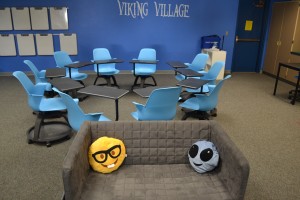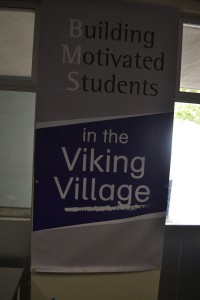
Emoji pillows sit comfortably in Benicia Middle School’s Viking Village, waiting for students and teachers to come into the new active learning center. (Photo by Nick Sestanovich)
One of the growing educational trends in recent years has been the implementation of active learning classrooms. These are rooms that provide a 21st century learning environment with laptops, tablets, interactive whiteboards, ergonomic seats and tables and more with the goal of having students become more involved in the educational process in innovative new ways. Such classrooms have been utilized at various institutions at both the K-12 and college level and first arrived at Benicia Unified School District in 2014 with Benicia High School’s Active Learning Space. Now this kind of setting has arrived at Benicia Middle School in what is simply known as the Viking Village.
One would assume the “village” in the title was chosen as a complementary alliteration to the school’s mascot, but Principal Damian Scott assures that it is actually in reference to the funding received through the community and groups like the Benicia Parent Teacher Student Association and Benicia Education Foundation.
“It was created by a village,” he said.
Located in a former keyboarding classroom, the Viking Village offers a variety of stations where students can learn from. Some chairs and tables are raised high above the ground, some are lower and arranged in a circular fashion with movable seats. Students can also sit on exercise ball chairs, bean bag chairs and even plush couches with emoji pillows.
In addition to providing a variety of places to sit, the center offers a variety of technological devices including Chromebooks, iPads and screens to project videos to.
Scott sums up the center as “different spaces and places for kids to work together.”
“It’s really a model of what we want classrooms to look like, what we want students to experience in the classroom moving forward,” he added. “It’s about collaboration, students working together and thinking.”
Vice Principal Maya Nelson says the room provides a more flexible educational setting than the traditional classroom.
“Whatever project they’re working on, they can choose to sit wherever they want to, they can choose whatever type of device they want to use for whatever project suits the class,” she said.
Scott also said the school recruited technology and integration coach and teacher on special assignment Alberto Barcenas to work in the Viking Village.
“He’ll be housed here mostly,” he said. “He’s basically there to work with teachers on how to use flexible spaces and technology for student learning and to support teachers in that endeavor,” he said.
The goal, Scott says, is to get students interested in learning via a new environment.
“My main expectations and hope is that students are excited for learning, they’re engaged,” he said. “It connects them to the real world. When you’re working in the real world, it’s not about you at a desk. It’s you working with your colleagues and learning from each other, and they can kind of take ownership of their learning. They’re not just sitting there being passive, they’re creating the learning and projects and creating a product whether it’s a video presentation or skit.”
Nelson came up with the center’s slogan “Building Motivated Students,” which shares an acronym with the school itself.
“It’s more student-centered learning,” she said. “The teacher, in turn, does almost less teaching because they’re giving them the idea and they get to create and guide themselves through the project.”
“The teacher’s not, for lack of a better term, the sage on the stage,” Scott said. “They’re more of a facilitator, but the benefit is they get to spend more one-on-one or small-group time with students. If you’re standing in front of the class, you’re the holder of the information. Now the students can find that information, the teacher’s more of a facilitator, coach and thinking partner.”
Scott says the Viking Village has been a huge hit among students. In an email asking students what their favorite thing about the year has been so far, the top two responses were the annual Viking Night, which was held Sept. 16, and the Viking Village.
“It’s positive, and I know some teachers are clamoring to get in here because everyone wants to explore it and use it,” he said. “Really our job now is to figure out how we expand it beyond this room.”
Nelson thanked the donors for allowing the center to come together, reiterating that it took a village to create the Village.
“Without the funding, we wouldn’t be able to do this,” she said. “It’s really been nice to be able to use that funding to put right back into our kids’ classrooms.”







Leave a Reply